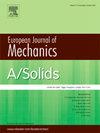Practical methods for the implementation of material strength into an Eulerian hydrocode
IF 4.4
2区 工程技术
Q1 MECHANICS
引用次数: 0
Abstract
This study presents the framework and implementation of a material strength model within a two-step Eulerian solution scheme in the MHD hydrocode, B2. The techniques presented in this work provide practical solutions to problems encountered when modelling high strain-rate behaviour of solids in an Eulerian framework. Several novel methods developed in this work resulted in the accurate reproduction of a Taylor anvil-on-rod test in B2 without a complex and computationally expensive interface reconstruction technique. These methods include a complete algorithmic definition of the different components of the stress tensor, ensuring realistic behaviour in low-density mixed cells at the rod-vacuum boundary through a density dependent modification of the yield, implementing automatically generated slip conditions at part boundaries, and damping oscillating numerical instabilities induced by the inclusion of strength. The Taylor test served as a rigorous verification case for the strength model, demonstrating the efficacy of these novel methods. A cross-code comparison against the results of a Lagrangian simulation in Ansys AUTODYN, a well-benchmarked commercial code which employs Young’s Reconstruction, of the Taylor rod deformation revealed a close match with the rod profile predicted by B2. In this article, emphasis is placed on the practical details of the routines required to implement these corrections to facilitate the adoption of three-dimensional material strength models in other Eulerian hydrocodes.
实用的方法实现材料的强度成欧拉氢码
本研究提出了MHD hydrocode, B2中两步欧拉解方案中的材料强度模型的框架和实现。在这项工作中提出的技术为在欧拉框架中模拟固体的高应变率行为时遇到的问题提供了实际的解决方案。在这项工作中开发的几种新方法导致了B2中Taylor砧上棒测试的精确再现,而无需复杂且计算昂贵的界面重建技术。这些方法包括对应力张量的不同分量的完整算法定义,通过对屈服的密度相关修改来确保在杆-真空边界的低密度混合单元中的真实行为,在部分边界实现自动生成的滑移条件,以及阻尼由包含强度引起的振荡数值不稳定性。Taylor试验作为强度模型的严格验证案例,证明了这些新方法的有效性。与Ansys AUTODYN中拉格朗日模拟的结果进行交叉代码比较,发现Taylor杆变形与B2预测的杆轮廓非常吻合。在本文中,重点放在实现这些修正所需的例程的实际细节上,以促进在其他欧拉氢码中采用三维材料强度模型。
本文章由计算机程序翻译,如有差异,请以英文原文为准。
求助全文
约1分钟内获得全文
求助全文
来源期刊
CiteScore
7.00
自引率
7.30%
发文量
275
审稿时长
48 days
期刊介绍:
The European Journal of Mechanics endash; A/Solids continues to publish articles in English in all areas of Solid Mechanics from the physical and mathematical basis to materials engineering, technological applications and methods of modern computational mechanics, both pure and applied research.

 求助内容:
求助内容: 应助结果提醒方式:
应助结果提醒方式:


